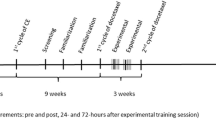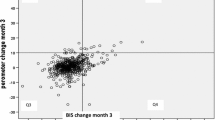Abstract
The development of secondary arm lymphoedema after the removal of axillary lymph nodes remains a potential problem for women with breast cancer. This study investigated the incidence of arm lymphoedema following axillary dissection to determine the effect of prospective monitoring and early physiotherapy intervention. Sixty-five women were randomly assigned to either the treatment (TG) or control group (CG) and assessments were made preoperatively, at day 5 and at 1, 3, 6, 12 and 24 months postoperatively. Three measurements were used for the detection of arm lymphoedema: arm circumferences (CIRC), arm volume (VOL) and multi-frequency bioimpedance (MFBIA). Clinically significant lymphoedema was confirmed by an increase of at least 200 ml from the preoperative difference between the two arms. Using this definition, the incidence of lymphoedema at 24 mo. was 21%, with a rate of 11% in the TG compared to 30% in the CG. The CIRC or MFBIA methods failed to detect lymphoedema in up to 50% of women who demonstrated an increase of at least 200 ml in the VOL of the operated arm compared to the unoperated arm. The physiotherapy intervention programme for the TG women included principles for lymphoedema risk minimisation and early management of this condition when it was identified. These strategies appear to reduce the development of secondary lymphoedema and alter its progression in comparison to the CG women. Monitoring of these women is continuing and will determine if these benefits are maintained over a longer period for women with early lymphoedema after breast cancer surgery.
Similar content being viewed by others
References
Brennan MJ: Lymphoedema following the surgical treatment of breast cancer: a review of pathophysiology and treatment. J Pain Symp Manag 7: 110–116, 1992
Kissin MW, Querci della Rovere G, Easton D, Westbury G: Risk of lymphoedema following the treatment of breast cancer. Brit J Surg 73: 580–584, 1986
Yeoh E, Denham J, Davies S, Spittle M: Primary breast cancer: complications of axillary management. Acta Radiol Oncol 25: 105–108, 1986
Hoe AL, Iven D, Royle GT, Taylor I: Incidence of arm swelling following axillary clearance for breast cancer. Brit J Surg 79: 261–262, 1992
Segerstrom K, Berle P, Graffman S, Nystrom A: Factors that influence the incidence of brachial oedema after treatment of breast cancer. Scand J Plast Recon Surg Hand Surg 26: 223–227, 1992
Spratt JS, Donegan WL: Surgical management. In: Donegan WL, Spratt JS (eds) Cancer of the Breast. 4th edn, WB Saunders, Philadelphia, 1995, pp 443–504
National Health and Medical Research Council (NHMRC): Clinical Practice Guidelines: The Management of Early Breast Cancer. NHMRC National Breast Cancer Centre Publications, Sydney, 1995
Mortimer PS, Bates DO, Brassington HD, Stanton SWB, Strachan, Levick JR: The prevalence of arm oedema following treatment for breast cancer. Quart J Med 89: 377–380, 1996
National Health and Medical Research Council National Breast Cancer Centre (NBCC): Lymphoedema: Prevalence, Risk Factors and Management: A Review of Research. NHMRC National Breast Cancer Centre Publications, Sydney, 1997
Kissane DW, Clarke M, Ikin J, Blocah S, Smith GC, Vitetta L, McKenzie DP: Psychological morbidity and quality of life in Australian women with early-stage breast cancer: a cross-sectional study. Med J Aus 169: 192–196, 1998
Ryttov N, Holm N, Qvist N, Blichert-Toft M: Influence of adjuvant irradiation on the development of late arm lymphoedema and impaired shoulder mobility after mastectomy for carcinoma of the breast. Acta Oncol 27: 667–670, 1988
Földi E, Földi M, Clodius L: The lymphoedema chaos: a lancet. Ann Plast Surg 22: 505–515, 1989
Wingate L, Croghan I, Natarjan N, Michalek A, Jordan C: Rehabilitation of the mastectomy patient: a randomised, blind prospective study. Arch Phys Med Rehab 70: 21–24, 1989
Gerber L, Lampert M, Wood C, Duncan M, D'Angelo T, Schain W, McDonald H, Danforth D, Findlay P, Glatstein E, Lippman M, Steinberg S, Gorrell C, Lichter A, Demoss E: Comparison of pain, motion and edema after modified radical mastectomy vs local excision with axillary dissection and radiotherapy. Breast Cancer Res Treat 21: 139–145, 1992
Hladiuk M, Huchcroft S, Temple W, Schurr BE: Arm func-tion after axillary dissection for breast cancer: a pilot study to provide parameter estimates. J Surg Oncol 50: 47–52, 1992
Mortimer PS (1995) Managing lymphoedema. Clin Exp Dematol 20: 98–106
Casley-Smith JR: Modern treatment of lymphoedema. Modern Med Aust, May, 70–83, 1992
Tobin M, Lacey H, Meyer L, Mortimer P: The psychological morbidity of breast cancer-related arm swelling. Cancer 72: 3248–3252, 1993
Maunsell E, Brisson J, Deschenes L: Arm problems and psychological distress after surgery for breast cancer. Can J Surg 36: 315–320, 1993
Box R, Reul-Hirche H: Results of a quality improvement project evaluating a physiotherapy programme for women after breast cancer surgery (abstract). Proc Nat Congress of the Australian Physiotherapy Association, 1996
Box RC: Rehabilitation after breast cancer. In: Sapsford R, Bullock-Saxton J, Markwell S (eds) Women's Health: A Text-book for Physiotherapists. WB Saunders, London, 1998, pp 454–465
Box RC, Reul-Hirche HM, Bullock-Saxton JE, Furnival CM: Shoulder movement after breast cancer surgery: results of a randomised controlled study of postoperative physiotherapy. Breast Canc Res Treat 75: 35–50
Box RC: The evaluation of a physiotherapy management care plan for women undergoing breast cancer surgery. PhD Thesis, Physiotherapy Department, University of Queensland, Australia, 2000
Box RC, Reul-Hirche HM, Bullock-Saxton JE: The intra-and inter-tester reliability of three measurement methods for the early detection of lymphoedema after axillary dissection. Eur J Lymph 27: 74–79, 1999.
Ward LC, Bunce IH, Cornish BH, Mirolo BR, Thomas BJ, Jones LC: Multi-frequency bioelectrical impedance augments the diagnosis and management of lymphoedema in post-mastectomy patients. Eur J Clin Invest 22: 51–754, 1992
Christensen SB, Lundgren G: Sequelae of axillary dissection vs axillary sampling with or without irradiation for breast cancer. Acta Chir Scand 155: 515–520, 1989
Cornish BH, Bunce IH, Ward LC, Jones LC, Thomas BJ: Bioelectrical impedance for monitoring the efficacy of lymphoedema treatment programmes. Breast Cancer Res Treat 38: 169–176, 1996
Megens A, Harris S: Physical therapist management of lymphoedema following treatment for breast cancer: a critical review of its effectiveness. Phys Ther 78: 1302–1311, 1998
Petrek JA, Pressman PI, Smith RA: Lymphedema: Current issues in research and management. CA-A Cancer J Clin 50: 292–307, 2000
National Breast Cancer Centre (NBCC): Lymphoedema following treatment for breast cancer: some potential approaches to answering priority research questions. Draft document for the NHMRC National Breast Cancer Centre Summit, Adelaide, 2000
Tengrup I, Tennvall-Nittby L, Christiansson I, Laurin M: Arm morbidity after breast-conserving therapy for breast cancer. Acta Oncol 39: 393–397, 2000
Keramopoulos A, Tsionou C, Minaretzis D, Michalas S, Aravantinos D: Arm morbidity following treatment of breast cancer with total axillary dissection: a multivariate approach. Oncology 50: 445–449, 1993
Carroll D, Rose K: Treatment leads to significant improvement: effect of conservative treatment on pain in lymphoedema. Prof Nurse 8: 32–33, 1992
Boris M, Weindorf S, Lasinski B, Boris G: Lymphoedema reduction by noninvasive complex lymphoedema therapy. Oncology 8: 95–106, 1994
Edwards T: Prevalence and aetiology of lymphoedema after breast cancer treatment in Southern Tasmania. Aust NZJ Surg 70: 412–418, 2000
Kosir M, Rymal C, Koppolu P, Hryniuk L, Darga L, Du W, Rice V, Mood D, Shakoor S, Wang W, Bedoyan J, Aref A, Biernat L, Northouse L: Surgical outcomes after breast cancer surgery: measuring acute lymphoedema. J Surg Res 95: 147–151, 2000
Ramos S, O'Donnell L, Knight G: Edema volume, Not timing, is the key to success in lymphoedema treatment. Am J Surg 178: 311–315, 1999
International Society of Lymphology Executive Committee: The diagnosis and treatment of peripheral lymphoedema. Lymphology 28: 113–117, 1995
Author information
Authors and Affiliations
Rights and permissions
About this article
Cite this article
Box, R.C., Reul-Hirche, H.M., Bullock-Saxton, J.E. et al. Physiotherapy After Breast Cancer Surgery: Results of a Randomised Controlled Study to Minimise Lymphoedema. Breast Cancer Res Treat 75, 51–64 (2002). https://doi.org/10.1023/A:1016591121762
Issue Date:
DOI: https://doi.org/10.1023/A:1016591121762




